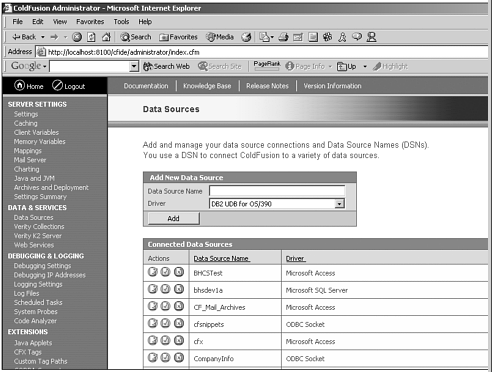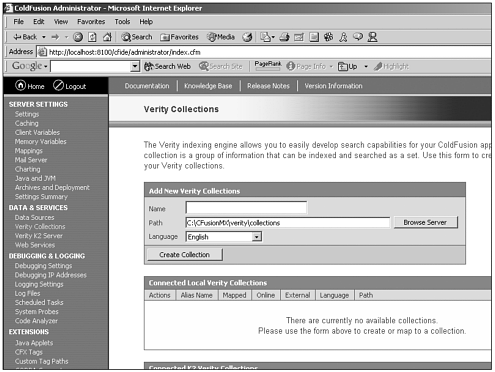Data and Services
| Looking at the left navigational bar, the next header we encounter is the Data and Services header. Beneath this header, you find several clickable menu items that control how datasources and other external configurable data components behave. We examine this section in detail in the following sections. Data SourcesFirst, let's look at the Data Sources page. Figure 25.11 gives you a look at page inside the Administrator. Figure 25.11. Data Sources page in the ColdFusion Administrator. The Data Sources page enables you to create, edit, configure, and delete external datasources that you'd like to use with your ColdFusion applications. There's nothing particularly tricky about this section of the Administrator. You simply choose the appropriate driver for the database to which you want to connect, enter the appropriate connection information, and begin using your database. Verity CollectionsNext, let's look at the Verity Collections page. Figure 25.12 gives you a look at the page inside the Administrator. Figure 25.12. Verity Collections page in the ColdFusion Administrator. On this page, you can add a new verity collection to the ColdFusion Server by naming the collection you want to create and pointing to an appropriate directory of files on your server. Beyond that, you can also repair, optimize, purge, and delete existing verity collections from this page. Table 25.6 discusses each verity management option.
Web ServicesNow, let's look at the Web Services page. Figure 25.13 gives you a look at the page inside the Administrator. Figure 25.13. Web Services page in the ColdFusion Administrator. The main purpose of this page of the ColdFusion Administrator is to enable you to register your web services with a name so that when you call them from your code, you do not need to enter the full Web Services Description Language (WSDL) URL. This enables easier and cleaner CFML code. |
EAN: 2147483647
Pages: 579


